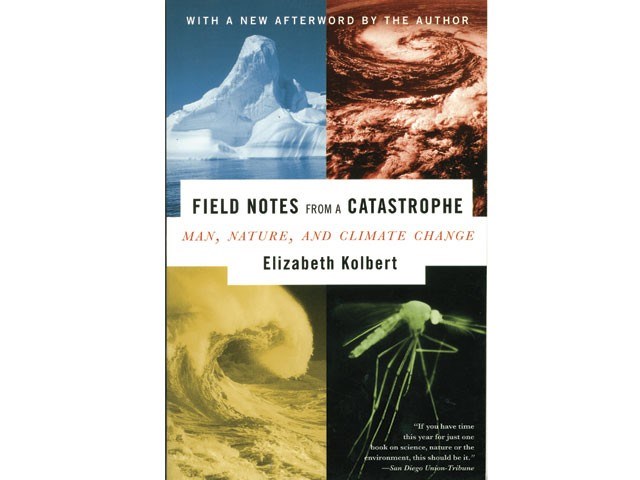Field
Notes from a Catastrophe, by Elizabeth Kolbert
Bloomsbury
$17.95,
225 pgs.
By Holly
Fraughton
As someone
who is somewhat perplexed by science, but very interested in environmental
issues, I reach a bit of an impasse when it comes to the topic of global
warming.
While I’d
love to learn more, I’m usually deterred by confusing and convoluted
information, laden with complicated scientific terms, but am constantly on the
lookout for interesting, but simple, explanations of environmental phenomena.
Elizabeth
Kolbert’s
Field Notes from a Catastrophe
is a frank, refreshing examination of global
warming, complete with diagrams for the scientifically challenged (read: me).
Kolbert’s
background in journalism is an incredible asset to a book of this nature, as
she has a natural knack for explaining scientific terms and processes in an
easy to understand, interesting manner. She’s even thrown a few illustrations
and graphs in for good measure.
The book,
in Kolbert’s words, is “about watching the world change.” It actually started
out as a three-part series for the New Yorker, which won Kolbert a National
Magazine Award in 2006.
She
traveled all over the world – to places like the Arctic circle, northern
England, and the Netherlands – doing research, talking to scientists, and
learning about our rapidly changing climate, and she includes vivid
descriptions of the people, places and things she encounters in her book. These
descriptions help Kolbert engage readers in the subject matter, almost making them
feel like they’re on the road with her.
On her
first stop in Shishmaref, Alaska, Kolbert meets with local residents to talk
about the dramatic changes they’ve noticed in their own backyards.
“Morris
Kiyutelluk, who is sixty-five, has lived in Shishmaref almost all his life.
(His last name, he told me, means ‘without a wooden spoon.’) I spoke to him
while I was hanging around the basement of the village church, which also
serves as the unofficial headquarters for a group called the Shishmaref Erosion
and Relocation Coalition. ‘The first time I heard about global warming, I
thought, I don’t believe those Japanese,’ Kiyutelluk told me. ‘Well, they had
some good scientists, and it’s become true.’”
Kolbert
doesn’t forget to back up her observations with fact, either.
At some
points, she includes a little too much scientific “fact” for my taste. While
she explains things like the difference between perennial and seasonal ice, and
makes references to the “terminal moraine” and Holocene interglacial, there
were a few moments when I struggled to keep my eyes from drifting to the next
page in search of an interesting character, interview or story.
She helps
to balance this overload of technical information with colourful historical
references, like the Swedish chemist, Svante Arrhenius’s, predictions about
carbon dioxide levels rising in the early 1900’s, and information about the
first official study of global warming, sanctioned by American president Jimmy
Carter in 1979.
While
Field
Notes from a Catastrophe
certainly illustrates the magnitude of global warming, and clearly
asserts that it is, in fact, a problem of epic proportions, Kolbert doesn’t go
over the top with fear-mongering – rather, she lets the information stand for
itself, allowing readers to draw their own conclusions from the information.
But there
are moments throughout the book where Kolbert’s sadness and passion for the
issue of climate change can’t help but shine through.
In one such
scene, Kolbert describes driving with a scientist to Deadhorse, Alaska, along
the Dalton Highway, which is edged by an aboveground oil pipeline and with
forest fires burning in the background.
“Just
beyond Coldfoot, we passed the tree line. An evergreen was marked with a plaque
that read ‘Farthest North Spruce Tree on the Alaska Pipeline: Do Not Cut.’
Predictably, someone had taken a knife to it. A deep gouge around the trunk was
bound with duct tape. ‘I think it will die,’ Romanovsky told me.”




